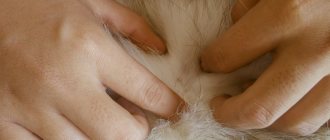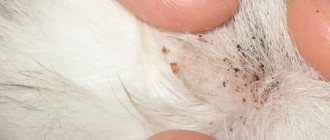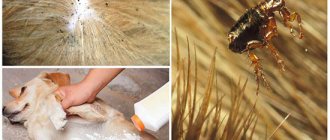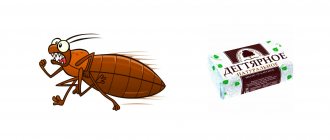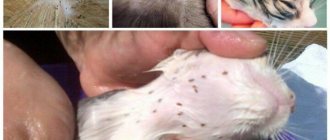Signs of fleas
Fleas on a cat
Reproduction of fleas and their eggs
Diseases transmitted by insects
Removing fleas from cats
A cat in a house is the favorite of all residents, bringing comfort and warmth to it. In return, owners take care of the pet’s health and appearance. The main problem that all owners face is the appearance of fleas in cats, which often bother them with their bites.
Ways of occurrence of fleas and symptoms
Fleas in cats are parasites that are most often found in the summer in animals that go outside. Their appearance in the fur requires an immediate reaction from the owner aimed at destruction. Such parasites are carriers of various diseases and pose a threat not only to cats, but also dangerous to humans, because they can also bite people.
If insects multiply heavily in your pet's fur, diseases such as anemia, weakened general immunity, and others are possible. As a result, every owner should know what fleas look like on cats, where they come from and the signs of parasites in a pet, and then think about how to get rid of them.
Ways of parasites appearing in domestic animals:
- accidental introduction of flea eggs or larvae from the street or from the entrance; according to statistics, 95% of these insects live in the basements of apartment buildings;
- from a neighboring apartment where there are infected pets;
- after contact with yard or wild dogs and cats.
Signs of the presence of fleas
In modern cities, there are a large number of homeless animals, and the presence of unsanitary conditions contributes to the reproduction and comfortable existence of various types of parasites that migrate and infect pets.
On a note!
Fleas often carry worm eggs, so after eliminating ectoparasites from a pet, it should be additionally treated with anthelmintic drugs.
Symptoms indicating the presence of fleas in a cat:
- the animal behaves restlessly, actively itches, tries to bite off parasites and licks itself;
- some cats become nervous due to constant itching;
- Living adult insects can be found among the undercoat;
- red dots appear on the skin at the sites of bites; if an infection occurs, they become inflamed and can develop into wounds, possibly causing dematitis;
- black dots are visible among the fur - flea excrement;
- Pests can be found in places where a cat cannot reach them: near the ears, in the armpits, on the back, chest and neck.
If you suspect that cats have fleas, you should carefully examine the fur for the presence of black spots of digested blood. Flea feces, when rubbed with your fingers, are separated into small particles that are clearly visible among the hairs. If the undercoat is short, the animal combs it onto the floor, where it can become food for the larvae.
How does a cat get fleas if he doesn't go outside?
A cat can easily become infected with fleas. She doesn't have to walk outside to do this. Infection can occur:
- upon contact with stray animals (cats, dogs, birds), if they get into the house, or with other pets, if they go outside, for example, a dog, or new pets;
- when visiting a veterinary clinic;
- through a person’s shoes and clothing;
- insects can themselves enter the house (entrance, balcony, etc.);
- in contact with rodents (mice, rats).
Also read the article about why even a domestic cat can have fleas and what to do in this case.
Appearance
The cat flea (Ctenocephalides felis) belongs to the order of wingless insects that feed on the blood of mammals. Usually fleas parasitize on a certain type of animal: feline fleas on cats, canine fleas on dogs, rat fleas on rodents, as well as rabbits and birds, but if necessary, they can easily change the type of host. Moreover, in appearance they are almost identical, so only an entomologist can determine the exact variety.
Fleas on a cat
What does a flea look like on a cat:
- the flea's body has a laterally flattened shape, which helps it quickly move between the hairs;
- the dense shell is covered with bristles, with which it clings to wool or feathers;
- the chitinous cover is very durable and difficult to crush with your fingers; the insect can only be destroyed by crushing it between the nails or on a hard surface (see photo of a flea on a cat);
- The flea size is 1-5 mm, on average - about 2-3 mm, and females are larger due to the round abdomen in which they carry eggs; after saturation with blood, the parasite increases almost 2 times.
The color of fleas living in a cat's fur often depends on whether they are hungry or have already drunk blood: it can vary from light red to dark brown, almost black. They absorb blood through their proboscis, which they use to pierce the skin and suck out food.
The main difference between fleas is their incredible jumping ability and speed of movement among fur; it is almost impossible to catch it with your fingers.
On a note!
Long strong legs give the insect the ability to move quickly and jump at any angle in length and height at a distance of up to 30 cm, for which fleas are considered one of the best jumpers in the world. At the end there are 2 claws for attaching to wool.
At the back of the insect there is a tactile organ consisting of sensitive hairs. Fleas do not have wings; in the process of evolution, they adapted to a parasitic lifestyle and lost their flight apparatus.
How quickly do fleas reproduce?
In general, we can say that fleas reproduce very quickly. Under certain conditions, the cycle during which a larva hatches from an egg, molts three times, turns into a pupa, an adult emerges from it, mates and lays a new clutch (the so-called “from egg to egg” cycle) takes 9-10 days.
Simply put, the change of generations occurs in fleas within a little more than one week. But this is a rather rare case. More often, in normal apartment conditions under a cat’s bedding (or in a fox or gopher burrow in nature), fleas go through this cycle in three to four weeks.
Generally speaking, it is in apartments or utility rooms, where a comfortable temperature is maintained all year round, that fleas multiply most quickly.
Fleas go through three stages of development: egg, larva, imago (adult). Going through all stages of the cycle takes from several weeks to several months. The speed of development depends on living conditions.
Fleas lay eggs in waste and dust that accumulate in rooms, houses and animal beds. Unlike many other insects, fleas do not carry their offspring with them.
They lay two to thirteen eggs after eating. The female lays the largest number of eggs in the last days of her life. Unlike the eggs of other parasites, flea eggs are not sticky and simply fall to the ground after being laid.
Larva
Detection of larvae in places where dust accumulates is very difficult due to their size
Flea larvae are white transparent, from 3 to 5.2 mm in length. The body darkens as it absorbs food. The larvae have a worm-like appearance and molt twice during their life cycle. The larval stage can take up to 18 days, after which the larva is wrapped in a silky cocoon and enters the pupal stage. The pupal stage can be completed in three days or even last up to a year.
Unlike adults, larvae do not feed directly from the food source, but consume organic matter: food crumbs, dead skin, dead insects, pieces of fur, and primarily the excrement of adults - they contain undigested blood. The larvae are born blind and detect adults by their excrement, a sign that a food source is nearby.
After hatching from the egg, the larvae look for shelter - cracks, gaps and crevices in the floor, under furniture, and bed.
Adults move quickly through space until they find a food source
Flea reproduction
A female flea can lay up to 10 eggs per day, which she shoots in her fur onto the skin without attaching them to anything. They are very small, about 0.5 mm, white, visually similar to semolina groats. You can see what flea eggs look like in cats in the photo below.
Reproduction of fleas and their eggs
The eggs easily slide off the fur, onto the floor or into the grass outside when walking. The flea larvae in cats that hatch after 14 days look like small dark worms that lack legs and eyes. The size of the larvae can reach 6 mm with a thickness of about 1 mm. They feed on organic waste or blood particles from flea feces.
Habitats for flea larvae: dust on the floor, carpets and furniture, various fleecy fabrics, ceiling cracks. Therefore, regular cleaning of the house with a vacuum cleaner will help greatly reduce the number of larvae and fleas in the apartment.
How to kill flea larvae
You can get rid of parasite larvae using:
- aerosols and sprays;
- powders;
- dust;
- concentrated products;
- microcapsule preparations.
How to get rid of flea larvae - remedies and folk methods
You can get rid of insect caterpillars using the same means as against fleas. Spraying substances – sprays, aerosols. Particularly convenient in hard-to-reach places. "Dichlorvos", "Raptor", "Clean House".
Concentrated products that are diluted with water - “Executioner”, “Cucarachi”, “Tetrix”, “Karbofos”. It is used to treat furniture, floors, and baseboards.
Powders and dusts are the most effective preparations. They must be placed in the habitats of worms. They eat the insecticide along with their food - organic waste. The disadvantage is that it is difficult to use in hard-to-reach places - under the floor, for example. "Clean house".
Suspensions help get rid of parasites and their larvae in the shortest possible time. The popular Get product is effective and safe for people and animals.
Folk methods for getting rid of caterpillar parasites include:
Boric acid mixed with vegetable powder. Mistaking this for food, the worms become poisoned. This mixture is not dangerous for people, but you should still avoid inhaling it and wear a protective mask. It is necessary to treat the lower surfaces - floors, carpets, furniture, bedding and animal litter. Vacuum after 12 hours. Using bait. Pour water and any detergent into a bowl. Place overnight in a dark room with a low lamp on. Insects will jump into the light and become trapped.
Spray the affected areas with lemon water.
Herbs - wormwood, tansy, eucalyptus, cedar sawdust are useless against caterpillars. Finely ground salt. Sprinkle the floor and carpet well with it and leave for 5-7 days. Then vacuum it. Over time, salt crystals damage the soft body of the caterpillar through friction and it dies. Be sure to throw away the bag in the vacuum cleaner and buy a new one. Along with treating the premises, it is necessary to carry out disinfestation of pets.
How to get rid of flea larvae in cats and dogs?
Parasites do not reproduce in the fur of pets. They lay eggs in other places. Animals can be charged only in extreme cases. Bathing a dog or cat with regular, even non-insecticidal, shampoo washes out not only eggs and worms, but also fleas. Their paws are not designed to hold on to hairs or fur like lice.
For prevention, you can wash the animal with tar soap. It does not kill parasites, but it repels them with its smell.
Do flea larvae bite?
Caterpillars do not attack humans or animals and do not feed on blood from the victim. They eat organic waste and excrement, including that of adults. For warm-blooded creatures, at this stage of development, they are safe.
Flea nutrition
Fleas differ according to the type of host in whose fur they parasitize, what kind of parasites there are - cat, dog, rabbit, bird, etc. - depends on the type of animal. Each type of flea has adapted over the years to the structure and temperature of the skin, blood components and other characteristics of the mammal. If there is a lack of food, they can try to bite and consume the blood of another owner; from this point of view, cat fleas are the most picky: they are able to feed on both a dog and a person.
Moreover, adult insects do not live permanently in the host’s fur, but jump to it only during meals. Their main habitats are things and surfaces not far from the cat. They prefer to eat food daily, but can go hungry for a long time, up to several months.
The only exception is the ectoparasites of nomadic animals (camels, sheep, etc.), they constantly live on their bodies in the wool.
Interesting!
Fleas are the only representatives of insects that have not changed over the past 50 million years, i.e. ancient specimens are identical to modern ones.
Harm to humans
The damage caused by ectoparasites to people is as follows:
- Bites.
- Transmission of contagious diseases.
Bites
A flea bite is regarded by the body as an irritant:
- A rash appears.
- Scratching appears, fraught with the development of suppuration.
- Dermatitis occurs, which can transform into pyoderma.
- Superficial lymph nodes become hypertrophied.
- Insomnia, migraine, diarrhea, and difficulty breathing develop.
Fleas are stuck
Transmission of contagious diseases
Cat fleas transmit the following infectious diseases to humans:
- Anthrax.
- Tifa.
- Encephalitis.
- Brucellosis.
- Worms.
Diseases transmitted by blood-sucking insects
Diseases transmitted by insects
Fleas bite people only out of hunger, when their main host is absent. Single bites also occur when the apartment is highly infested with parasites.
What is dangerous about fleas living on cats is that they can transmit helminths that settle inside the fleas while they are looking for a new host. There are also microorganisms that fleas transmit:
- mycoplasmosis, which affects the body, causing purulent inflammatory processes;
- rickettsiosis - causes fever.
A bite can transmit bacillary angiomatosis to a person, infection of which is impossible without insects. However, it must be taken into account that other types of pests that transmit other types of diseases can also parasitize cats’ fur.
Interesting!
Among the flea family, rat species are especially dangerous because... they are capable of carrying infectious diseases: typhus, plague, etc. In the Middle Ages, half the population of cities and countries died as a result of epidemics of diseases transmitted by rats.
Development and nutrition of larvae
In general, the process of flea development from egg to adult lasts from three weeks to several months.
The eggs hatch into larvae after two days or two weeks. The length of the period depends on humidity and temperature conditions.
Externally, the larvae have the shape of white worms. Through the translucent body you can see the esophagus, which looks like a dark blotch. The length of flea larvae reaches 5 mm as they grow.
Parasites move like all worms - in segments. They cannot bite or drink blood like adults. Therefore, they get its dried remains, excrement of adults, and organic waste.
REFERENCE: The habitats of adults and larvae are noticeably different. If adults can often be seen on the animal’s fur or near its bedding, then the larvae can even breed close to the trash can.
While the larva is growing, it molts three times. Then a cocoon is formed. In terms of size, the flea pupa can be mistaken for a dark-colored speck. Its dimensions do not exceed 5 mm. Over time, the cocoon increases.
When an adult insect emerges from it depends on temperature conditions. Sometimes development can slow down during the pupal stage for up to a year or more. The young individual is initially light in color. With active feeding, it becomes stronger, and its integument darkens.
REFERENCE: Adults and pupae can withstand temperatures down to minus 40 degrees, but eggs and larvae die in light frost.
The life cycle of an adult lasts no more than three months. During this time, the flea makes about a hundred bites on average. At relatively low temperatures, fleas can live up to two years. In the cold, their growth slows down, and in the warmth, fleas become stronger and differ in size.
Insects of complete metamorphosis vary at different stages. Flea larvae are not similar in appearance to their adult relatives. They have a different food source and behavioral characteristics. When fighting fleas, you should treat not only the animal’s fur, but also the pet’s habitat.
This will help destroy the parasite eggs. After some time, it is recommended to re-process. Since fleas can spend a long time in the pupal state. And only after waiting for favorable conditions do they quickly develop, turning into an adult.
Consequences for the cat
Ectoparasite bites cause a lot of unpleasant and painful sensations, which often affects the health of an adult cat and, especially, a small kitten. Signs of flea bites on a cat are red, inflamed dots on the skin.
With a large number of ectoparasites, the following negative consequences are possible:
- when an infection gets into the wound, inflammation can begin, the formation of sores and crusts, which the animal rips off and continues scratching;
- furunculosis and ulcers on the skin, the formation of pustules and pustules;
- skin irritations contribute to the appearance of allergic dermatitis or dermatophiliasis;
- loss of tufts of hair in places where there are many bites, which leads to swelling of the affected area.
